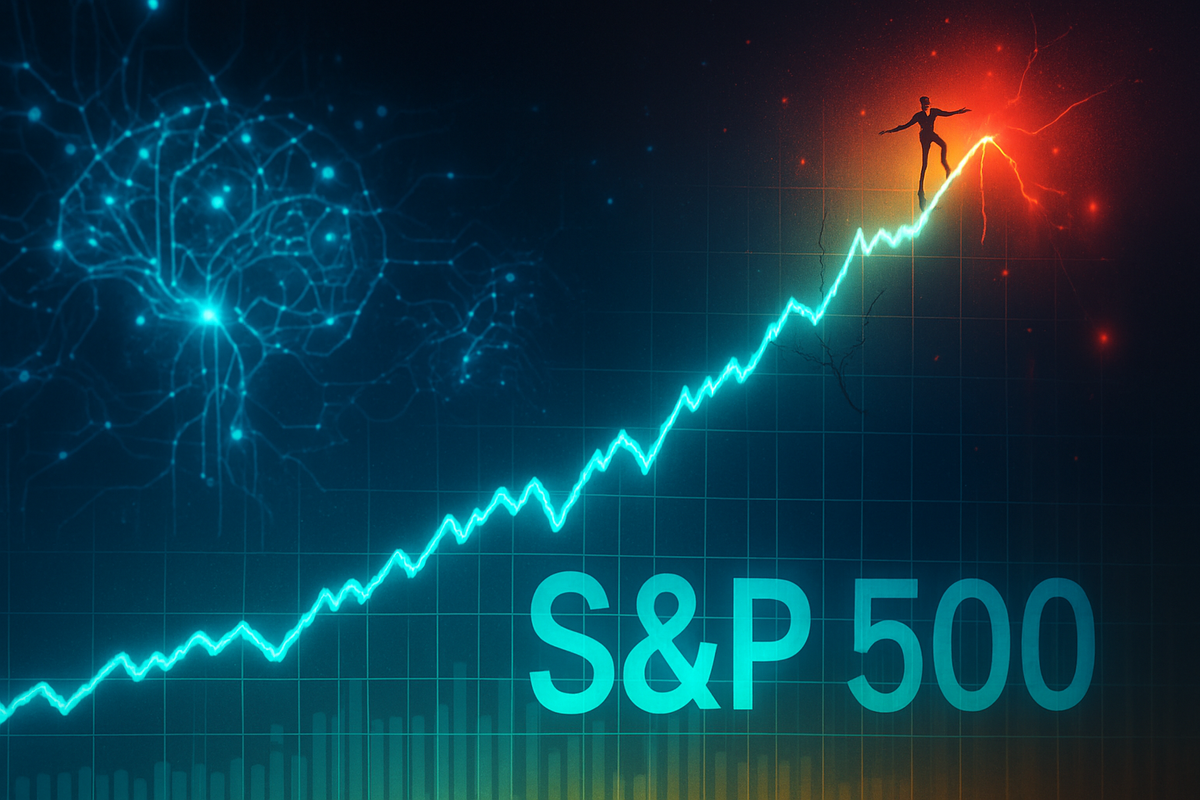
The S&P 500 (SPX) has been on an exhilarating ascent, repeatedly smashing through record highs, fueled largely by an insatiable appetite for artificial intelligence (AI) innovation and robust corporate earnings. As of October 7, 2025, the benchmark index continues to bask in optimism, with its year-to-date gains hovering around 15-17%. However, beneath the surface of this impressive rally, a chorus of technical indicators and historical comparisons are beginning to sing a cautionary tune, suggesting that the market's winning streak may be approaching a point of exhaustion. Investors are now grappling with the delicate balance between undeniable technological advancement and the potential for a significant market recalibration.
The AI-Driven Juggernaut Encounters Resistance
The current market rally, which has seen the S&P 500 achieve its best Q3 performance since 2020, rising by over 7.8%, is undeniably rooted in the transformative power of artificial intelligence. Companies across various sectors are pouring massive investments into AI infrastructure, with technology giants like Nvidia (NASDAQ: NVDA) reportedly reaching a staggering $4.5 trillion market valuation, leading the charge. This AI-fueled enthusiasm has propelled the market to new peaks, even as the Federal Reserve has embarked on an easing cycle, cutting interest rates by 0.25% in Q3 2025—the fourth such reduction since September 2024, bringing the Fed Funds rate to 4.00%-4.25%. These cuts are largely a response to a softening job market, including a July jobs report showing a significant miss on employment gains and a rising unemployment rate.
Despite the prevailing bullish sentiment, which has pushed the CNN Money Fear & Greed Index into the "Greed" zone, several technical and analytical signals are flashing red. On October 4, 2025, the S&P 500's price action formed a "topping tail" candlestick pattern, a classic indicator where strong buying pressure is ultimately overcome by significant selling, suggesting a potential exhaustion of upward momentum. Furthermore, the Relative Strength Index (RSI) across daily, weekly, and monthly charts has entered "overbought" territory (above 70), indicating that the market may be stretched and vulnerable to a pullback. Hedge fund legend Paul Tudor Jones has even drawn parallels to the dot-com bubble of the late 1990s, warning of a potential "blow-off" top driven by speculative behavior, particularly within the AI sector.
The timeline leading to this precarious moment includes a period of robust corporate earnings, with Q3 2025 S&P 500 earnings growth estimated at a healthy 7.9% to 8.0% year-over-year, defying initial expectations of a slowdown. The Information Technology sector, in particular, boasted an estimated 20.9% growth rate. However, amidst this earnings strength, inflation readings have crept higher in Q3 2025, partly due to new tariffs imposed by President Trump in April 2025, which initially caused a sharp, albeit temporary, 12% drop in the S&P 500. The ongoing partial U.S. government shutdown, while initially shrugged off by markets, adds another layer of uncertainty, with potential GDP implications if prolonged. Key players in this dynamic include the Federal Reserve, whose monetary policy directly impacts liquidity, and the dominant technology companies whose performance heavily influences the index.
Navigating the Shifting Sands: Potential Winners and Losers
A potential slowdown or correction in the S&P 500's winning run would undoubtedly create a divergence between market segments, leading to clear winners and losers. Companies that have been at the forefront of the AI rally, particularly those with high valuations and aggressive growth projections, could face the most significant headwinds. Tech giants and other high-growth stocks that have been largely responsible for the index's ascent may see their valuations scrutinized more intensely, especially if the broader market sentiment shifts from "Greed" to "Fear." Investors might rotate out of these speculative plays, seeking safer havens.
Conversely, a market correction could present opportunities for value stocks and sectors that have been overlooked during the AI-driven euphoria. Defensive sectors such as Utilities, Consumer Staples, and Healthcare, which tend to be less sensitive to economic cycles, might see increased investor interest. Companies with strong balance sheets, consistent dividends, and stable earnings, regardless of their growth prospects, could become attractive. Furthermore, any companies that benefit from a potential cooling of inflation or a more cautious economic outlook, such as those in essential services, could fare better.
The impact on specific companies will vary. Highly capitalized technology firms like Nvidia (NASDAQ: NVDA), Microsoft (NASDAQ: MSFT), and Apple (NASDAQ: AAPL), which have heavily contributed to the S&P 500's performance, would likely experience significant volatility if the market corrects. Their high price-to-earnings ratios could become targets for profit-taking. On the other hand, companies in sectors like industrials or financials, particularly those with strong regional ties or robust lending portfolios, might find relative stability. Small-cap stocks, which showed signs of outperforming large-caps in Q3 2025, could either suffer disproportionately in a downturn or, if the correction is seen as a healthy rebalancing, could continue their relative outperformance if investors seek diversification beyond mega-cap tech.
Broader Implications and Historical Parallels
The potential exhaustion of the S&P 500's winning run fits into several broader industry trends and economic narratives. The relentless focus on AI, while revolutionary, has created a concentration risk within the market, with a handful of mega-cap technology companies exerting outsized influence on index performance. This concentration echoes historical periods, such as the dot-com bubble, where a narrow set of companies drove market gains, only to see a dramatic unwinding. The current environment, characterized by strong corporate earnings but also creeping inflation and a softening job market, creates a complex backdrop where the market is "walking a tightrope between an AI boom and an economic slowdown."
Ripple effects could extend to various sectors. Partners and suppliers to the dominant AI players could face reduced demand if investment slows. Financial institutions might brace for increased volatility and potential credit tightening if economic conditions deteriorate. Regulatory bodies may also increase their scrutiny of market concentration and potential anti-competitive practices within the technology sector, especially if speculative behavior becomes more pronounced. Historically, periods of rapid technological advancement leading to market exuberance have often been followed by corrections, serving as a reminder that even transformative technologies are subject to market cycles. The current situation bears resemblances to the late 1990s, where innovation was undeniable, but valuations became unsustainable.
The Federal Reserve's actions are a critical policy implication. While the Fed has been cutting rates due to a weakening labor market, persistent inflation, exacerbated by tariffs, could complicate future monetary policy decisions. If inflation proves sticky, the Fed might face pressure to pause or even reverse its easing cycle, which would likely dampen market sentiment further. The ongoing government shutdown also highlights political gridlock as a potential systemic risk, capable of eroding business and consumer confidence if not resolved swiftly. The interplay of monetary policy, fiscal policy (tariffs, government spending), and technological disruption creates a unique and challenging landscape for the market.
What Comes Next: Scenarios and Adaptations
Looking ahead, several short-term and long-term possibilities emerge for the S&P 500. In the short term, a period of consolidation or a modest correction appears increasingly likely given the technical exhaustion signals and elevated valuations. This could manifest as a sideways trading range or a single-digit percentage pullback, offering a healthier reset for the market. Investors might witness increased sector rotation, with capital flowing out of high-growth technology stocks into more defensive or value-oriented plays. The resolution of the U.S. government shutdown and upcoming inflation data will be critical catalysts in determining the immediate trajectory.
In the long term, the underlying AI revolution is expected to continue driving innovation and productivity gains, suggesting that any market correction might be a temporary recalibration rather than a protracted bear market. However, companies will need to adapt strategically. Those heavily invested in AI must demonstrate tangible returns on their investments, moving beyond speculative promises to concrete profitability. Companies with strong balance sheets and diversified revenue streams will be better positioned to weather increased market volatility. Strategic pivots may include focusing on cost efficiencies, strengthening supply chains, and exploring new markets to mitigate risks associated with a concentrated tech-driven rally.
Market opportunities could emerge for astute investors willing to buy dips in fundamentally sound companies or invest in undervalued sectors. Challenges will include navigating persistent inflation, potential interest rate uncertainty if the Fed's easing path becomes less clear, and geopolitical risks that can quickly shift market sentiment. Potential scenarios range from a "soft landing" where the market experiences a healthy correction before resuming its upward trajectory, to a more significant downturn if economic data deteriorates rapidly or if the speculative bubble in certain tech segments bursts. Investors should prepare for increased volatility and a more discerning market environment.
Comprehensive Wrap-Up: Vigilance in a Volatile Market
The S&P 500's impressive winning run, propelled by the AI revolution and robust corporate earnings, is undeniably a testament to market resilience and innovation. However, as of October 7, 2025, the confluence of technical exhaustion signals—such as topping tail candlesticks and overbought RSIs—alongside warnings of speculative excess from seasoned market observers, indicates that the market is at a critical juncture. The key takeaway for investors is that while the long-term prospects of AI remain strong, the short-term market dynamics suggest a need for increased vigilance and a cautious approach.
Moving forward, the market is likely to be characterized by heightened volatility and a greater emphasis on fundamental value. The days of indiscriminate buying across growth stocks may be drawing to a close, paving the way for a more selective investment landscape. Investors should assess their portfolios for concentration risk, particularly in mega-cap technology stocks, and consider diversifying into sectors that offer stability or are currently undervalued. The interplay of monetary policy, inflation trends, and corporate earnings reports will continue to be dominant market movers.
The lasting impact of this period will depend on whether the current signs of exhaustion lead to a healthy correction that rebalances valuations, or if speculative fervor overwhelms fundamentals, leading to a more severe downturn. What investors should watch for in the coming months includes further inflation data, the Federal Reserve's commentary on future rate decisions, the resolution of the government shutdown, and, critically, the earnings reports of major technology companies for signs of sustained profitability versus mere revenue growth. This is not a time for complacency, but rather for strategic positioning and careful risk management.
This content is intended for informational purposes only and is not financial advice





